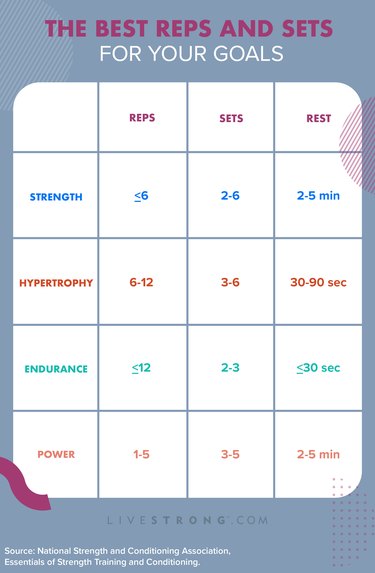


If you could look inside the heads of most people at the gym, you'd probably see their minds doing one of the three things during their workout — thinking about work, singing along with the songs in their headphones or counting out their reps and sets. Let's take a closer look at that last one. Specifically, how many reps should you do during your own workout? And what about sets?
What Are Sets and Reps?
Video of the Day
First things first: What do these words even mean?
Video of the Day
Reps is short for repetitions, meaning the number of times you do a certain exercise. Sets refer to the number of times you do a specific amount of reps.
So if you are going to do 10 reps and 3 sets of an exercise, that means you'll do the exercise 10 times, rest, and then repeat those 10 reps two more times for a total of 3 rounds. You'll have done the exercise a total of 30 times: 1 set of 10, a second set of 10 and a third set of 10.
Knowing how many sets and reps you should do of any given exercise depends mostly on your fitness goals, says Anthony Wall, CPT, a certified personal trainer and senior director of global development at the American Council on Exercise (ACE).
"We want to start with their goals and build from there," Wall explains. "We also look at health and exercise experience as well, but the driving factor is what they would like to accomplish."
Your Guide to Reps and Sets by Goal
Different rep and set schemes affect your body in specific ways. There is some overlap, but generally speaking, when you lift for fewer reps and sets, that means you're lifting much heavier weight than when you're lifting a weight you need to sustain for longer. That difference in weight is generally what accounts for the different impact a certain rep-set scheme will have on your muscles.
Below are the general guidelines for strength training reps and sets depending on your workout goal.
Reps | Sets | Rest | |
|---|---|---|---|
Strength | ≤6 | 2 to 6 | 2 to 5 minutes |
Hypertrophy | 6 to 12 | 2 to 6 | 30 to 90 seconds |
Endurance | ≥12 | 2 to 3 | ≤30 seconds |
Power | 1 to 5 | 3 to 5 | 2 to 5 minutes |
1. Reps and Sets for Muscle Strength
- Compound exercises: 2 to 6 sets of 6 or fewer reps
- Isolation exercises: 1 to 3 sets of 8 or fewer reps
Training for strength is all about increasing the maximum amount of force a muscle can exert in a single contraction.
Building strength involves breaking down (via lifting heavy things) muscle fibers so that they can repair and regrow stronger. It also involves some good ol' brain-muscle connection: When you lift weights, you build new connections between your brain and muscles so that over time, they know exactly how to contract properly when you lift something heavy. This neurological change further increases how much you can lift.
According to the National Strength and Conditioning Association (NSCA), the best reps and sets for strength are doing either 2 to 6 sets of 6 or fewer reps (with 2 to 5 minutes of rest in between) or doing 1 to 3 sets of 8 or fewer reps (with roughly 90 seconds to 2 minutes of rest in between). Why two different recommendations?
Because the first rec is for multi-joint compound moves like deadlifts, squats, chin-ups and bench presses. The second is for isolation exercises like biceps curls and triceps extensions.
For maximal strength gains, train to fatigue. A good way to think about it is to consider your repetition maximum (RM). This refers to the maximum weight you can lift if you were to just give it all you've got. So, you'll want to lift close to your 6RM or 8RM — the amount you can lift in 6 or 8 reps — to truly fatigue and maximize strength gain.
The right weight is one that you can lift so that the last 2 reps are very difficult, but you can still get through them without breaking form. If you're more advanced and can lift heavier weight, that will be a higher weight at a lower rep and set range than if you're relatively new to lifting and are using a lighter weight.
Quick note for newbies: Lifting anything heavier than your 8RM is not advised. So if you're new to lifting, or even to a specific exercise, start with hypertrophy ranges (below) and then you can think about lifting heavier weights for fewer reps once you have a good foundation with the move.
2. Reps and Sets for Muscle Size (Hypertrophy)
- 3 to 6 sets of 6 to 12 reps
Hypertrophy, or muscle size, is different from strength in that it is more focused on building the size of the muscle. However, most people who are not elite athletes or bodybuilders will get a little bit of both strength and hypertrophy from their strength workouts, Wall says.
To build muscle, use a set and rep scheme of 3 to 6 sets of 6 to 12 reps with 30 to 90 seconds of rest between each exercise and between sets. Rest periods also play into whether you're primarily building strength vs muscle mass — strength typically calls for more rest between exercises than hypertrophy.
When it comes to reps and sets for muscle size, the main goal is increasing volume.
Volume is essentially weight times reps. It tells you how much, really, you're lifting. So, if you bench pressed 10-pound dumbbells for 3 sets of 10, that's 20 pounds times 30 reps, for a total training volume of 600 pounds.
Rep and set schemes for hypertrophy involve lifting a moderately heavy weight for a moderate amount of sets and reps. As a result, your training volume is nice and high. This also means the total amount of time your muscles spend under tension is pretty long, and time under tension is one of the main drivers of muscle growth.
Similarly to strength training, you want to also train to fatigue if you're focusing on hypertrophy. So, that means using the right weight for a 6RM to 12RM. It's a wide range, so if you're just starting out, start on the higher end of the rep range so that you're using a lighter weight. As you get stronger, you will increase the weight and decrease the number of reps you do.
This is where most people are going to spend the bulk of their workouts. Even though this rep and set scheme is technically for "hypertrophy," you're still going to build strength, endurance and even some power here too.
3. Reps and Sets for Muscular Endurance
- 2 to 3 sets of 12 or more reps
Muscular endurance is all about being able to sustain an activity or movement over a long period of time. It's important for sports like running or cycling, where your muscles need to repeatedly exert force to sustain you over many miles.
You also rely on muscular endurance for a lot of everyday activities — for example, sitting at a desk with proper posture requires long-term engagement of your abdominals and upper back.
For muscular endurance, the NSCA recommends exercisers lift light loads for 2 to 3 sets of 12 or more reps. Rest periods should be short at 30 seconds or less. By reducing your weight and extending the time your muscles are under tension, you train them to hold up for the long haul — vs just being able to move a huge amount of weight in one big push and then getting to rest.
4. Reps and Sets for Muscular Power
- 3 to 5 sets of 1 to 5 reps
Muscular power is the ability to produce a large amount of force in a short period of time. Think: power cleans and box jumps. Anything that involves doing a high-intensity movement quickly.
For muscular power, the NSCA suggests lifting 3 to 5 sets of 1 to 5 reps, resting 2 to 5 minutes in between exercises and sets.
Muscular power is especially important for certain sports, like football, sprinting and anything that involves throwing, like shot put or javelin throws.
For the average exerciser who isn't training for a specific sport, power training is still functionally beneficial. Being able to react and generate force quickly can help you react to things in everyday life.
For example, if your kid falls off the playground and you have to jump quickly to catch them, or you are crossing the street and a car comes out of nowhere without looking or you need to jump over a creek on a hike. All of these things require you to react and move, and power training makes sure your muscles are prepared.
Each rep here should feel very hard — in RM terms, you should feel like you can't do any more than the 1 to 5 reps you set out to do. Beginners should start on the higher rep end with less weight, even starting with body-weight exercises. Work your way up to more resistance and fewer reps as you build explosive strength.
So, How Many Reps and Sets Should You Do?

For the most well-rounded health and fitness, most people will do a combination of exercises for strength, size, endurance and power. Here are some example sets and reps combinations.
For a lower-body day, you might do:
- 3x3 box jumps (power)
- 4x6 deadlifts (strength)
- 3x10 glute bridges (hypertophy)
- 2x15 calf raises (endurance)
And then on an upper-body, you could do:
- 3x5 medicine ball throws (power)
- 5x5 bench presses (strength)
- 3x10 bent-over rows (hypertrophy)
- 2x15 scaption raises (endurance)
You can also make your whole workout focused on one goal — just make sure you're dedicating other days to training the other types of fitness training.
When to Switch Up Your Set and Rep Schemes
While these general guidelines are great for planning your workouts, remember that they're just that: guidelines. You don't need to get so stuck in a rep and set scheme that you're afraid to ever stray from. That strict mindset can set you up for overtraining and injury.
"While there are scientific principles behind this, everyone is an individual," Wall adds. The right number of reps and sets for you and your workout buddy might differ — that's why there's a range instead of a hard and fast number.
"Ranges allow us to modify a little bit and tailor the workout. So perhaps you do more sets on the lower body than you do on the upper body, or maybe you are stronger with pushing than pulling," Wall says.
Feel free to modify from workout to workout and from exercise to exercise so that the workout feels right for you. As you get stronger and increase the weight you lift, you can move to a new rep and set scheme to keep your workouts progressing.
The fact is that life's more complicated than a set program. Your kids get sick, your boss makes you pull a double-shift or your homework takes longer than you thought it would. And there are days when you're not firing on all cylinders. On those days when you come to the gym stressed, ill or exhausted, pushing for 10 reps for 3 straight sets may actually be counterproductive in the long run.
To determine the approach that will work best for you, you should understand the fundamental approaches to sets and reps — and the results they tend to produce. Then take a look at your training strengths and weaknesses and learn how to evolve your thinking to produce even better results.
Related Reading